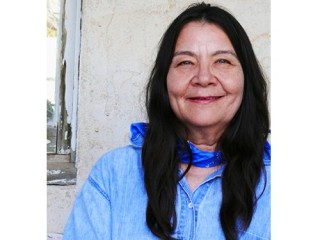
Leslie Silko biography
Date of birth : 1948-03-05
Date of death : -
Birthplace : Albuquerque, New Mexico
Nationality : Native American
Category : Famous Figures
Last modified : 2011-10-14
Credited as : author, Native American literary, renaissance
Leslie Silko is one of the foremost authors to emerge from the Native American literary renaissance of the 1970s. She blends western literary forms with the oral traditions of her Laguna Pueblo heritage to communicate Native American concepts concerning time, nature, and spirituality and their relevance in the contemporary world.
Silko, of Laguna Pueblo, Plains Indian, Mexican, and Anglo-American descent, was born in Albuquerque and raised on the Laguna Pueblo Reservation in northern New Mexico. As a child she attended schools administered by the Bureau of Indian Affairs and also learned about Laguna legends and traditions from her great-grand-mother and other members of her extended family. She graduated magna cum laude from the University of New Mexico in 1969 and briefly attended law school before deciding to pursue a writing career. While working on her fiction, Silko has taught at several universities and colleges throughout the southwest. She is also the single parent of two sons.
Silko's first novel, Ceremony (1977), is a nonchronological work that interweaves free verse poetry and narrative prose. The story is set primarily in the years following World War II and revolves around Tayo, a veteran of mixed white and Laguna heritage who returns to the reservation shattered by his war experiences. He ultimately finds healing, however, with the help of Betonie, an elderly man who, like Tayo, is an outcast from Laguna society due to his white heritage, and T'seh Montano, a medicine woman who embodies the feminine, life-giving aspects of the earth. Through them, Tayo learns that his community's ancient ceremonies are not merely rituals, but a means of achieving one's proper place within the universe. To underscore this concept, Silko incorporates Laguna myths and historical incidents, reflecting the Pueblo's abiding connection to the natural world which counteracts the despair and alienation engendered by white society. Critics applauded Ceremony, echoing Frank McShane's estimation that the novel "is one of the most realized works of fiction devoted to Indian life that has been written in this country, and it is a splendid achievement."
Silko's next work, Storyteller (1981), is comprised of poems from her earlier collection Laguna Woman (1974) as well as short stories, anecdotes, folktales, historical and autobiographical notes, and photographs. According to Bernard A. Hirsch, "this multigeneric work lovingly maps the fertile storytelling ground from which [Silko's] art evolves and to which it is here returned—an offering to the oral tradition which nurtured it." Several of the pieces from this work have been accorded significant attention. One such story, "Yellow Woman," is based on traditional abduction tales in which a kachina, or mountain spirit, kidnaps and seduces a young woman on her way to draw water. In Silko's version, a contemporary Pueblo woman realizes that her liaison with a cattle rustler is in fact a reenactment of the "yellow woman" legend. The boundary between her experience and the myth slowly dissolves as she becomes aware of her active role in the traditions of her community. Upon returning to her family, she hopes that the story of her affair will be passed on as a new episode in the visionary drama kept alive by the oral tradition.
In Almanac of the Dead (1991) Silko presents an apocalyptic vision of North America in which Native Americans reclaim their ancestral lands after whites, lacking the spiritual and moral force of the Indian world, succumb to crime, perversion, drug addiction, and environmental degradation. Some critics have objected to what they perceived as Silko's exaggeration of corruption in Anglo-American society. Malcolm Jones, Jr., observed that "in [Silko's] cosmology, there are good people and there are white people." However, most have praised her vivid characterizations and inventive plotting, contending that while The Almanac of the Dead may perturb some white readers, it is a compelling portrait of a society founded upon the eradication of Native Americans and their cultures.
















